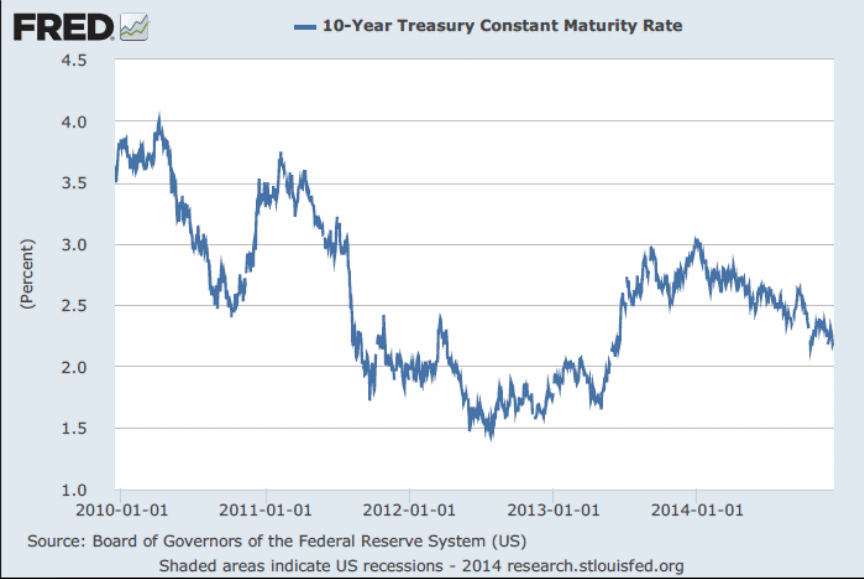Summary of the article
According to an article, Get Your Bonds Ready for a Fed Rate Boost by Michael A. Pollock, the latest trends have shown that yields are likely to rise in the year 2015. Hence, investors should be ready.
This year, many investors missed opportunities to get the right bond yields. They concentrated on mutual funds and ETFs to ensure protection against potential increments in long-term yields. These yields, however, did not surge as expected, but instead, they declined.
Six years have elapsed after “the Federal Reserve reduced standards rates to almost zero” (Pollock par. 4). Today, however, many investors believe that yields are likely to rise. It remains unclear when the Fed will increase rates to normal levels. According to Pollock, any rise in yields is likely to affect the bond portfolio negatively because a rise in yields leads to a drop in the price of a fixed-rate bond (par. 2).
There is so much uncertainty in the market. Investors, therefore, should diversify their bond portfolio. Individuals with bonds in a 401(k) plan have limited diversification options, but money markets and stable value funds are potential options. A sudden surge in the stock market could shock investors, while gradual developments may cause less discomfort. Investors with a portfolio in bond funds or exchange-traded funds in taxable accounts have several alternatives (Pollock par. 6).
Pollock advises that such investors should consider “bonds with different maturities and credit ratings, particularly many diverse ETFs or mutual funds” (Pollock par. 6). Some of the strategies for broadening bond portfolios include evaluating yield outlooks, better diversification, considering short-term yields, considering insurance against inflation, and evaluating floating-rate funds.
Analysis and Opinions
Several factors influence bond yields. They include portfolio shifts, economic growth, fiscal policy, credit quality, inflation rates, and competition for rates, among others. Today, the US has recorded significant improvements in the labor market, and there are positive economic indicators. As the graph below shows, interest rates have risen steadily since 2008 with strong performances in the past few months. Pollock notes that demands for loan funds have resulted in high rates of such funds.
According to a study by Guo et al. (e22794), the Fed has become progressively more watchful of stock market behaviors because such behaviors indicate recovery and US economic health. At the same time, long-term investors have also been more reactive and watchful of signals from the Fed and financial markets, particularly after the crunch. Therefore, Pollock points to normal behavior and possible reactions if the Fed raises interests, and the best solution, according to him, is to diversify a bond portfolio.
Scholars seem to support portfolio diversification as a means of risk management. It provides investors with opportunities to take advantage of low rates in certain portfolios and reduce panic in the bear market (Rotblut par. 23). Arnott observes that investors rely on bonds for two specific reasons, which include diversification and risk management (10-17).
Investors who use bonds generally do not expect lofty returns and expect their stock portfolio to perform better than a bond for any given long period. For instance, the below figure shows that prevailing fiscal market environments and extremely low levels of interest rates have occasioned negative yields for investors.
While bond portfolios provide alternatives for reducing risks, there are other means of investing and achieving true diversification and better returns. Nevertheless, investors should focus on low risks by diversifying some parts of their bond portfolios and studying market fundamentals to enhance their possibilities of striking the precise market yields in the future.

Works Cited
Arnott, Robert. “Bonds: Why Bother?” Journal of Indexes 12.3 (2009): 10-17. Print.
Guo, Kun, Wei-Xing Zhou, Si-Wei Cheng, and Didier Sornette. “The US stock market leads the federal funds rate and treasury bond yields.” PLoS ONE 6.8 (2011): e22794. Print.
Pollock, Michael A. “Get Your Bonds Ready for a Fed Rate Boost.” The Wall Street Journal. 2014. Web.
Rotblut, Charles. Portfolio Rebalancing: Diversification, Risk Control and Withdrawals. AAII Journal. 2012. Web.